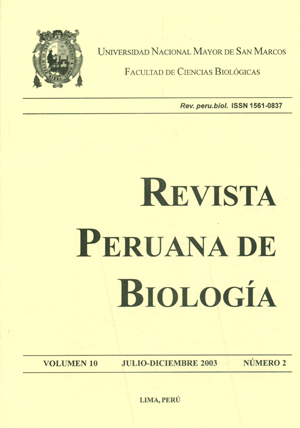Evaluation of the conservation status of the game mammals: a comparative model in communities of the Pacaya Samira National Reserve (Loreto, Peru)
DOI:
https://doi.org/10.15381/rpb.v10i2.2498Keywords:
Pacaya Samiria National Reserve, conservation status, wildlife animal densities, hunting impactAbstract
This paper contains information about the hunting, abundance and the hunting impact of the mammals that inhabit the lowland forests of the area surrounding two communities in the interior of the Pacaya Samiria National Reserve. It is based on hunting records and transect censuses. Hunting records show an average annual harvest of 190,3 mammals in the San Miguel area, equivalent to 2,275,9 kg of bushmeat; and 104,5 mammals in the Parinari area, equivalent to 985,9 kg of bushmeat. Primates were abundant in both study areas; however, the estimated densities were much higher in the Parinari area. No ungulates species were observed in the San Miguel area, whilst in the Parinari area the density of tapir (Tapirus terrestris Linnaeus) was estimated at 0,2 individuals/ km2 and that of white lipped peccary (Tayassu pecari Link) at 6, 6 individuals/km2 . Finally, the harvest model suggests overhunting of the tapir, white bellied spider monkey (Ateles belzebuth E. Geoffroy), common wooly monkey (Lagothrix lagotricha Humboldt) and red howler monkey (Alouatta seniculus Linnaeus), for which harvest in some cases reached 100% of the production. We discuss the factors that should influence the scarcity and/or absence of some species, particularly ungulates and primates.Downloads
Downloads
Published
Issue
Section
License
Copyright (c) 2003 Rolando Aquino, Arsenio Calle

This work is licensed under a Creative Commons Attribution-NonCommercial-ShareAlike 4.0 International License.
AUTHORS RETAIN THEIR RIGHTS:
a. Authors retain their trade mark rights and patent, and also on any process or procedure described in the article.
b. Authors retain their right to share, copy, distribute, perform and publicly communicate their article (eg, to place their article in an institutional repository or publish it in a book), with an acknowledgment of its initial publication in the Revista Peruana de Biologia.
c. Authors retain theirs right to make a subsequent publication of their work, to use the article or any part thereof (eg a compilation of his papers, lecture notes, thesis, or a book), always indicating its initial publication in the Revista Peruana de Biologia (the originator of the work, journal, volume, number and date).






